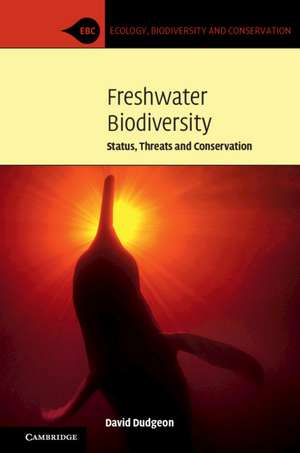Freshwater Biodiversity: Status, Threats and Conservation: Ecology, Biodiversity and Conservation
Autor David Dudgeonen Limba Engleză Paperback – 20 mai 2020
| Toate formatele și edițiile | Preț | Express |
|---|---|---|
| Paperback (1) | 355.36 lei 3-5 săpt. | |
| Cambridge University Press – 20 mai 2020 | 355.36 lei 3-5 săpt. | |
| Hardback (1) | 598.88 lei 3-5 săpt. | |
| Cambridge University Press – 20 mai 2020 | 598.88 lei 3-5 săpt. |
Din seria Ecology, Biodiversity and Conservation
-
 Preț: 349.59 lei
Preț: 349.59 lei -
 Preț: 276.13 lei
Preț: 276.13 lei -
 Preț: 230.82 lei
Preț: 230.82 lei -
 Preț: 307.24 lei
Preț: 307.24 lei -
 Preț: 356.75 lei
Preț: 356.75 lei -
 Preț: 274.22 lei
Preț: 274.22 lei -
 Preț: 303.90 lei
Preț: 303.90 lei -
 Preț: 351.53 lei
Preț: 351.53 lei -
 Preț: 305.81 lei
Preț: 305.81 lei -
 Preț: 320.13 lei
Preț: 320.13 lei -
 Preț: 278.29 lei
Preț: 278.29 lei -
 Preț: 353.48 lei
Preț: 353.48 lei -
 Preț: 328.88 lei
Preț: 328.88 lei -
 Preț: 311.14 lei
Preț: 311.14 lei -
 Preț: 387.22 lei
Preț: 387.22 lei - 11%
 Preț: 451.52 lei
Preț: 451.52 lei - 8%
 Preț: 530.72 lei
Preț: 530.72 lei -
 Preț: 314.82 lei
Preț: 314.82 lei -
 Preț: 306.10 lei
Preț: 306.10 lei -
 Preț: 471.17 lei
Preț: 471.17 lei -
 Preț: 466.38 lei
Preț: 466.38 lei -
 Preț: 402.68 lei
Preț: 402.68 lei - 14%
 Preț: 981.14 lei
Preț: 981.14 lei -
 Preț: 454.76 lei
Preț: 454.76 lei - 11%
 Preț: 565.77 lei
Preț: 565.77 lei - 14%
 Preț: 709.39 lei
Preț: 709.39 lei -
 Preț: 441.83 lei
Preț: 441.83 lei - 14%
 Preț: 929.04 lei
Preț: 929.04 lei - 11%
 Preț: 477.70 lei
Preț: 477.70 lei - 14%
 Preț: 701.48 lei
Preț: 701.48 lei - 14%
 Preț: 1013.18 lei
Preț: 1013.18 lei
Preț: 355.36 lei
Nou
Puncte Express: 533
Preț estimativ în valută:
68.01€ • 73.84$ • 57.13£
68.01€ • 73.84$ • 57.13£
Carte disponibilă
Livrare economică 01-15 aprilie
Preluare comenzi: 021 569.72.76
Specificații
ISBN-13: 9780521745192
ISBN-10: 0521745195
Pagini: 514
Ilustrații: 10 b/w illus. 25 colour illus. 14 tables
Dimensiuni: 152 x 228 x 25 mm
Greutate: 0.86 kg
Editura: Cambridge University Press
Colecția Cambridge University Press
Seria Ecology, Biodiversity and Conservation
Locul publicării:Cambridge, United Kingdom
ISBN-10: 0521745195
Pagini: 514
Ilustrații: 10 b/w illus. 25 colour illus. 14 tables
Dimensiuni: 152 x 228 x 25 mm
Greutate: 0.86 kg
Editura: Cambridge University Press
Colecția Cambridge University Press
Seria Ecology, Biodiversity and Conservation
Locul publicării:Cambridge, United Kingdom
Cuprins
Preface; 1. The freshwater commons; 2. Global endangerment of freshwater biodiversity; 3. Overexploitation; 4. Alien species and their effects; 5. River regulation: impacts and mitigation; 6. Vanishing lakes and threats to lacustrine biodiversity; 7. How will climate change affect freshwater biodiversity?; 8. Ecosystem services and incentivizing conservation of freshwater biodiversity; 9. Conservation of freshwater biodiversity: opportunities and initiatives; Index.
Recenzii
'Dudgeon (Univ. of Hong Kong) draws on his 40 years of experience as a freshwater ecologist to provide a comprehensive overview of scientific research on these impacts. He adopts a global approach in every chapter, offering detailed examples from worldwide sites, such as the Mekong Basin, Lake Victoria, and the Great Lakes. After describing the biodiversity of freshwaters and their many uses by people, Dudgeon focuses on the three major causes of declining biodiversity: overexploitation (from fishing and hunting), introduced species, and modification of rivers and lakes (through dams and water removal). Many of the best-documented cases of biodiversity decline are found among fish, but other animals are not neglected. Climate change and its future effects are addressed as well. The book closes with a discussion of ways in which people may work to prevent and undo the harm to freshwater ecosystems and the many species that depend on them.' M. P. Gustafson, Choice
'In Freshwater Biodiversity, Dudgeon presents an impressive compilation of the status, threats, and prospects of the Earth's freshwater biodiversity that will be of great use for professionals or students interested in freshwater conservation … readers interested in the freshwater conservation crisis will find this volume a valuable resource.' Windsor E. Aguirre, The Quarterly Review of Biology
'In Freshwater Biodiversity, Dudgeon presents an impressive compilation of the status, threats, and prospects of the Earth's freshwater biodiversity that will be of great use for professionals or students interested in freshwater conservation … readers interested in the freshwater conservation crisis will find this volume a valuable resource.' Windsor E. Aguirre, The Quarterly Review of Biology
Notă biografică
Descriere
Fresh waters are disproportionately rich in species, and represent global hotspots of biodiversity. However, they are also hotspots of endangerment.
